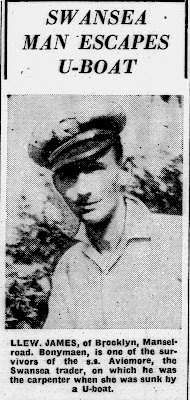Merchant Navy Day - S.S. Aviemore
Merchant Navy Day is observed on the 3rd of September or the nearest day.
The History of Merchant Navy Day, on the 3rd of September. On this day in 1939, the United Kingdom and France declared war on Germany reacting to Germany's invasion of Poland two days earlier. King George V bestowed the title of Merchant Navy on British merchant seafarers following the sacrifices of seafarers during the First World War. 3rd of September 2000 was the official day of Merchant Navy Day.
 |
| S.S. Athenia 1933 |
S.S. Athenia, under Captain James Cook's command,
left Glasgow on the 1st for Montreal. She was carrying 1,103 passengers – 500 Jewish
refugees, 4679 Canadians, 311 US citizens and 72 UK subjects, and a crew of
315. The following day, the 2nd
despite clear indications that war would break out any day S.S. Athenia
departed Liverpool. On the day of the
British declaration of war on Germany, 3rd, S.S. Athenia was 60
nautical miles south of Rockall, and 200 nautical miles south of Inishtrahall,
Ireland, when U-30 sighted it. U-30 followed Athenia for
three hours when both vessels were between Rockfall and Tory Island, when
commander Oberleutant Fritz-Julius Lemp, ordered that two torpedoes should be
fired. One exploded on Athenia’s port side in the engine room, when she
started to settle by the stern.
S.S. Athenia remained afloat for 14 hours, when she
finally sunk, the following morning, the 4th with the loss of 98
passengers and 19 crew.
 |
| S.S. Aviemore credit - uboat.net |
The Aviemore was 220 miles southwest of Cape Clear.
22 crew and the master were lost. 11
crew members were picked by H.M.S. Warwick and landed on the 18th
at Liverpool.
Aviemore was the first ship to be sunk during an
attack on a convoy.
 |
| Tower Hill Memorial credit - www.benjidog.co.uk |
 |
| South Wales Daily Post 21st September 1939 |
 |
| South Wales Daily Post 21st September 1939 |
The South Wales Daily Post, on the 21st of
September, reports the sinking and those that survived.
 |
| H.M.S. Warwick credit - uboat.net |
 |
| South Wales Daily Post 4th March 1944 |
H.M.S. Warwick, a Royal Navy destroyer with a crew of 160. U-413 fired two torpedoes at H.M.S. Warwick on 20th February 1944, 15 miles from Trevose Head, north Cornwall. Three officers and 64 crew members were lost in the sinking. One of those who lost their lives was Sidney Percival Coates, 18, Able Seaman. Coates, is commemorated on the Plymouth Naval Memorial.


Comments
Post a Comment